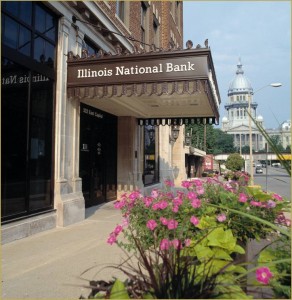 Buying an old utility company building to serve as a bank had its ups and downs. UP: The utility accepted customers’ payments at a number of cashier windows which would easily transform to bank teller windows. DOWN: Telling people who came to the windows that we couldn’t accept utility payments.
Buying an old utility company building to serve as a bank had its ups and downs. UP: The utility accepted customers’ payments at a number of cashier windows which would easily transform to bank teller windows. DOWN: Telling people who came to the windows that we couldn’t accept utility payments.
Jamie Singer, now a vice president in Treasury Services, was one of the first tellers to work from the old
CILCO (Central Illinois Light Co.) building at 322 E. Capitol Ave, in Springfield, Ill. She still works in the bank lobby today. But, she remembers, “We looked like a utility company for a long time.” And while telling people the bank WASN’T CILCO anymore wasn’t fun, she says the remodel was. “We got to work in hard hats around dust all day long. People came in just to see the transition. Everyone was curious as to what was going on in the heart of downtown Springfield.”
Jamie says she often has to remind herself not to take the location for granted. “People pay to come to Springfield to get the view I get walking into the building every day,” she says noting the close proximity to the Illinois State Capitol Building. During the height of tourist season, Jamie and the lobby staff often have visitors landing in the bank lobby looking for directions or an ATM machine.
“We work hard to make everyone feel welcome and go away with a good impression of the city,” she says.
Today she may not always have the time to visit with tourists, but in the early days, Jamie remembers fighting over anyone who came through the doors. “When there were just two to four customers a day, we all wanted to help.” Today, while everyone is still anxious to help customers, the doors to the downtown lobby open more frequently than they did in 1999.
But why did INB choose an old building in downtown Springfield? According to bank President and CEO Sarah Phalen, “downtown” was the essential element. “At the time, community banks were on the outskirts of the city. Only the big, national banks were downtown. Our board felt we should be in the epicenter. We also knew we had plans to serve government entities, so downtown was really the right location even though our choice was considered odd by many at the time.”
In 1999 when the bank opened, Sarah and others on the management team did anything and everything to make the bank a success. She worked the drive thru on Saturdays, took out the trash on “her” nights, and helped do a “deep clean” of the building. “The basement was packed with boxes of stuff. It took 20 of us a good part of a Saturday to just open the boxes and basically get them to the dumpsters.” She recalls one “find” that, until recently, was part of the bank’s rite of passage.
“We found this big piece of art that pictured horses running. I got on the back of a motorcycle holding it and snuck it in the newly opened Montvale location so it would greet Debbie Shelton when she opened the building on Monday.” That horse picture went on to greet many new employees over the years.
But at the end of the day, the downtown building was really just a building. Sarah says being part of the community is what made INB different from the other banks in downtown Springfield. “We came here to be a resource to business people, serve our community through lending, and make decisions that are right for everyone involved.” She remembers when The Hoogland Center was a dream for the local arts community. “The founders went around looking for financing, and no one would give it to them. We decided it was a risk we needed to take because this was going to be a place for kids to learn and adults to enjoy themselves.”
While Sarah calls herself a “peon” in those early days, she admired the foresight of those she was working for. “Our board and shareholders started this from scratch. They had belief and faith in us. We’ve grown under their leadership, and our values are the same as they were 17 years ago.”
Building’s History
The former CILCO building that serves as INB’s headquarters was designed by George H. Helmle, a local architect who designed most of the elegant and classical building in downtown Springfield in the early 20th Century. In 1922, Springfield Gas and Electric Co. became Illinois Power Co. Illinois Power started construction of the building in 1924 and moved in May 1925. CILCO was organized in 1933 and remained at the location until 1999 when INB opened for business.
The building has three floors and full basement. The structure is reinforced concrete with the exterior done in a Classical Revival in the Beaux-Arts tradition. The exterior building material is a crimson brick with limestone lentils, cornices, columns and key lock details
In 1925, the first floor was used by Illinois Power while the second and third floors housed apartments. Today, both floors are office space.
To hear first-hand from those who helped turn a power company office in INB, watch the short video on our website titled “Opened Main Branch at 322 E. Capitol.”